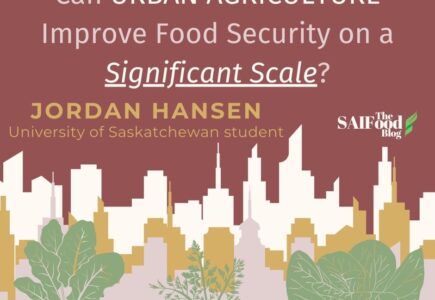By Jordan Hansen
University of Saskatchewan student
Introduction
The topic of urban agriculture is being discussed in major cities across the globe as more and more people move into urban centers. As of 2023, the World Health Organization estimates that 68% of the world’s population will live in cities by 2050. That accounts for over 6 billion people living in urban areas relying on global food systems and contributing to ongoing food security concerns.
Urban agriculture aims to improve both food security and provide sustainable production in people’s backyards. Some consider urban agriculture to be a way of “reconnecting with the community through food, jobs, and economic development,” while others consider it a way to improve food access to local communities. Regardless of how urban agriculture is defined, it requires community involvement and policy implementation to succeed. Ultimately, the question is whether or not policymaking and civic engagement is enough to improve food security on a large scale in urban areas.
City Policy Implementation – Getting Down and Dirty
Large cities in North America continue to implement policies as an attempt to encourage locally grown produce and bring people closer to their food. Cities without policy support have trouble producing and distributing food in accessible ways. For example, community gardens have been found to have the same harvest yields per area as commercial farm yield rates but tend to have spatial limitations. In some cases, the issue is not that urban farming can’t produce enough food for the public, but rather that they can’t generate enough revenue from selling food at an affordable price to cover operational costs. Because of this, there is no way to sustain cities on a large scale due to high costs of land and labour. In most cases, the responsibility falls on the community to work in urban farms and the cities to provide support.
Across Canada, urban centers are implementing sustainable food plans and green space initiatives. Edmonton’s Regional Agriculture Master Plan targets community involvement to increase accessibility and awareness. In 2012, RAMP promoted Fresh as their “food and urban agriculture strategy,” a stepping stone for local food production recommendations. Since then, implementation strategies have included the Vacant Lot Cultivation Pilot (ended 2018), community garden initiatives, edible fruit tree planting in collaboration with other city councils, and a number of other projects over the last 10 years.
The City of Saskatoon, similarly, has increased the number of community gardens from 3 (2008) to 30 (2021) and continues to add small scale landscapes to their urban production including, but not limited to, the 2019 Brownfield Renewal Strategy, as well as vacant lot, rooftop, and boulevard gardening. Additionally, Saskatoon’s Healthy Yards program provides workshops and presentations for home gardeners to encourage community involvement and education.
What Does This Mean?
Realistically, urban agriculture is not a perfect solution for improving food security. It requires a large amount of commitment and policy implementation and will, ultimately, never be enough to sustain the global system on its own. Rather, it provides food on a household level, with a lower distribution radius than that of large-scale farming.
Lack of space and high operation costs prevent urban agriculture from being a perfect system, particularly in crowded neighbourhoods. However, urban agriculture is a promising practice and should continue to be implemented in urban centres. Policy implementation provides vacant lots for community gardens and green spaces, while educational tools provided by city resources allow homeowners to grow their own food instead of relying solely on grocery store produce.
Some areas also found that in-school education on urban agriculture improved food access to students and families. Community gardens provide greenspace to people without their own area to grow. Cities, including Saskatoon and Edmonton, also have their own food councils, dedicated to providing policy recommendations, collaborating with citizens, and examining urban agriculture to create sustainable food systems.
It is clear that urban agriculture has a positive effect on food security and has many additional benefits. Aside from the increased accessibility to healthy foods, it gives people the opportunity for hands-on experience growing crops. Thus, people learn first-hand the issues growers face, be it pest management or weed control. It also offers psychological benefits like stress reduction and personal empowerment. However, without government funding and policy making, it has a much smaller impact.
Urban agriculture encompasses a large number of projects that may not fully remedy the issue of global food insecurity but can improve it through civic engagement and policy support.
Biography

Jordan Hansen is 21 years old and from Grande Prairie, Alberta. She is in the process of finishing a Bachelor of Science in Horticulture at the University of Saskatchewan with a minor in Agribusiness. She is the current President of the U of S Horticulture Club and has spent her summers working as a research assistant in Beaverlodge, Alta. After her degree, she intends on returning to Alberta and working to improve food security and educating the public on the importance of the Ag sector.


My thought that you could make the best progress working with a developer. You may only get one or two seasons use of the land but your best offer to them is weed control, reduced fire hazard and reduced chance of vandalism.